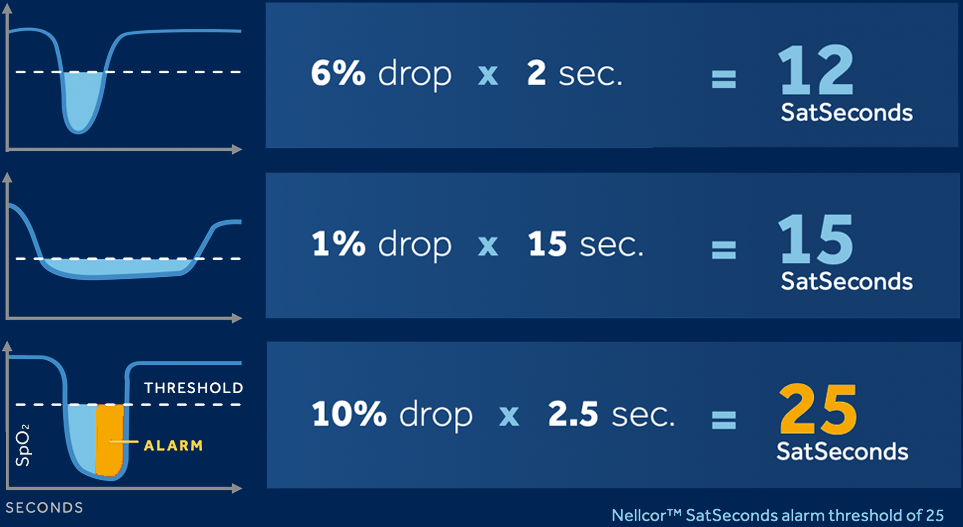

Nellcor™ SatSeconds
Alarm Management in Neonatal Monitoring
Newborn babies are constantly moving. Little wiggles, little stretches. All these tiny movements can set off alarms—even when there is no desaturation event. Nellcor™ SatSeconds alarm management is a clinician-controlled feature that has been shown to reduce nuisance alarms.1,2
It’s frustrating to respond to alarms that don’t need clinical intervention. We know alarm fatigue is real. And it can negatively impact your workflow, your patient’s experience, and your ability to provide the best possible care. That’s why when you hear an alarm, it’s vital to be able to trust it.
![]()
SpO2 is the most common alarm in the hospital3
85–99 percent of alarms don’t require clinical intervention4,5
Nellcor™ SatSeconds alarm management may reduce alarms in neonates by 40 percent1,2
NOTE: A third party study showed that at a setting of 50, nuisance alarms were reduced in the neonate population by 40%. Clinical judgment should be used to determine appropriate Nellcor™ SatSeconds alarm management settings.
The proprietary Nellcor™ SatSeconds algorithm generates alarms based on the severity of a drop in SpO2 and the length of the drop. SatSeconds filters out a very short dip in SpO2, and it filters out a very slight dip — helping to reduce nuisance alarms and alarm fatigue. If SpO2 drops below the alarm threshold for a longer period, the alarm will sound. So, you know the alarm is significant.

The Vital Sync™ solution gives you nearly real-time, actionable information that your clinical teams can access anytime, anywhere. It offers remote monitoring including alarm management, reporting, and EMR connectivity on almost any device. Be virtually with your patients wherever you are and prioritize care.
More about Vital Sync™ SolutionMedtronic is a proud sponsor of the AAMI Foundation’s National Coalition for Alarm Management and Safety. The AAMI offers an SpO2 alarm management toolkit that provides resources, strategies, and approaches mitigating clinically insignificant alarms.
LEARN MORE >The best way to see the difference with Nellcor™ pulse oximetry is to try it for yourself. Request a free demo today and experience peace of mind in neonatal monitoring. Please fill out the form below and a Nellcor™ pulse oximetry product specialist will contact you to set up a time to visit your facility.
The size, stability, and values of the company behind the products make a crucial difference to you and your patients. Our mission guides everything we do, including the meticulous standards-based research, development, and testing for which we’re known.
The Nellcor™ pulse oximetry monitoring system should not be used as the sole basis for diagnosis or therapy and is intended only as an adjunct in patient assessment.
1. Brostowicz HM. Oxygen Saturation in the Neonatal Intensive Care Unit: Evaluation of a New Alarm Management. American Academy of Pediatrics National Conference and Exhibition. October 2009.
2. Stefanescu BM et al. Improving Filtering of Pulse Oximeter Monitoring Alarms in the Neonatal ICU: Bedside Significance. Resp Care. 2016;61(1):85-89.
3. Graham KC, Cvach M. Monitor alarm fatigue: standardizing use of physiological monitors and decreasing nuisance alarms. Am J Crit Care. 2010;19(1):28-35.
4. Ver Hage A. Alarm fatigue can endanger patients. OR Today. May 1, 2015. Accessed 8/23/2019.
5. The Joint Commission. Medical device alarm safety in hospitals. Sentinel Event Alert. April 8, 2013; issue 50.